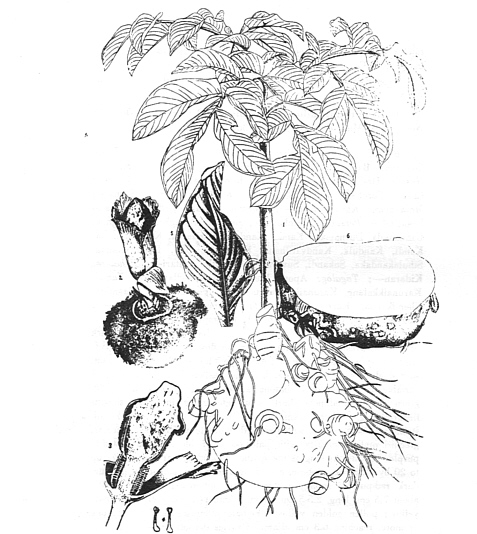

Zitierweise / cite as:
Carakasaṃhitā: Ausgewählte Texte aus der Carakasaṃhitā / übersetzt und erläutert von Alois Payer <1944 - >. -- Anhang A: Pflanzenbeschreibungen. -- Amorphophallus paeoniifolius (Dennst.) Nicolson. -- Fassung vom 2007-07-27. -- URL: http://www.payer.de/ayurveda/pflanzen/amorphophallus_paeoniifolius.htm
Erstmals publiziert: 2007-07-27
Überarbeitungen:
Anlass: Lehrveranstaltung SS 2007
©opyright: Dieser Text steht der Allgemeinheit zur Verfügung. Eine Verwertung in Publikationen, die über übliche Zitate hinausgeht, bedarf der ausdrücklichen Genehmigung des Verfassers
Dieser Text ist Teil der Abteilung Sanskrit von Tüpfli's Global Village Library
Falls Sie die diakritischen Zeichen nicht dargestellt bekommen, installieren Sie eine Schrift mit Diakritika wie z.B. Tahoma.
Verwendete und zitierte Werke siehe: http://www.payer.de/ayurveda/caraka0001.htm

Abb.: Amorphophallus paeoniifolius
(Dennst.) Nicolson = Elefantenkartoffel
[Bildquelle: Kirtikar-Basu, ©1918]
Drury:
"Amorphophallus campanulatus (Blume). N. O. Araceae. Telinga potato, Eng. Karuna, Mal. and Tam. Muncha Kunda, Tel. Ol, Hind.
Description.—Stemless; leaves decompound; flowers small, dark-coloured, sessile with respect to the surface of the ground, and appearing when the plant is destitute of leaves; spathe the length of the spadix, campanulate, margins curled ; nectary none ; club broad-ovate, lobate, anthers 2-celled. Fl. June.— Wight Icon. t. 782.—Arum campanulatum, Roxb.—Rheede, Mal. xi. t. 18, 19.-------Bengal. Peninsula.
Medical Uses.—The acrid roots are used medicinally in boils and ophthalmia. They are very caustic and abound in starch, and are employed as external stimulants, and are also emmenagogue.—(Lindley.) The fresh roots act as an acrid stimulant and expectorant, and are used in acute rheumatism.—Powell, Punj. Prod.
Economic Uses. —The roots are very nutritious, on which account they are much cultivated for the purpose of diet. They are planted in May, and will yield from 100 to 250 maunds per beegah, selling at the rate of a rupee a maund. The roots are also used for pickling. Wight says that " when in flower the fetor it exhales is most overpowering, and so perfectly resembles that of carrion as to induce flies to cover the club of the spadix with their eggs." A very rich soil, repeatedly ploughed, suits it best. The small tuberosities found in the large roots are employed for sots, and planted in the manner of potatoes. In twelve months they are reckoned fit to be taken up for use; the larger roots will then weigh from 4-8 or more pounds, and keep well if preserved dry. The natives employ them for food in the manner of the common yam. The plant is the Chaneh or Mullum chaneh of Rheede.—Jury Rep. M. E. Roxb."
[Quelle: Drury, Heber <1819 - 1872>: The useful plants of India : with notices of their chief value in commerce, medicine, and the arts. -- 2d ed. with additions and corrections. London : Allen, 1873. -- xvi, 512 p. ; 22 cm. -- s.v.]